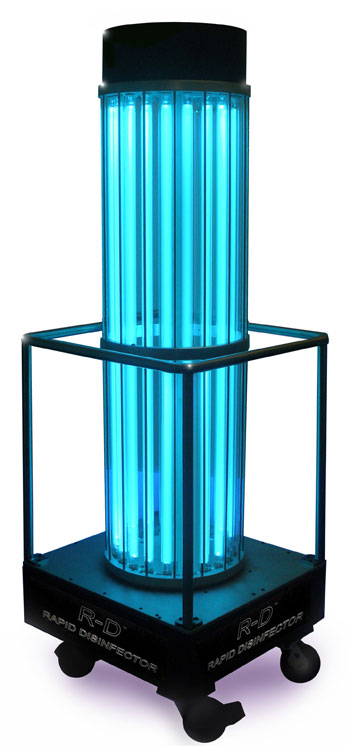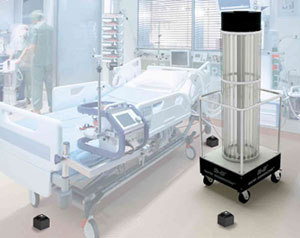Meet R-D: he shoots to kill
He bears a striking resemblance to his cousin Tru-D — and he shoots to kill.
R-D — short for Rapid Disinfector — is on a mission to eradicate bacteria and other dangerous pathogens at VGH. And he’s dead set on proving that he can do so better and faster than Tru-D.
 For up to eight weeks we’re putting R-D to the test to learn how well this machine on wheels can help us disinfect surfaces with ultraviolet (UV) light.
For up to eight weeks we’re putting R-D to the test to learn how well this machine on wheels can help us disinfect surfaces with ultraviolet (UV) light.
“Earlier this year VGH was the first hospital in Canada working with a Tru-D machine,” says Dr. Liz Bryce, regional medical director, infection control. “Our pilot demonstrated that UV disinfection can be a valuable adjunct to the cleaning process, and now we want compare how efficiently and effectively R-D accomplishes the same job.”
Aramark staff are trained to operate R-D, following standard housekeeping. “The machine is designed to complement — not replace — housekeeping services,” explains Dr. Titus Wong, medical microbiologist. “No machine can replace the human touch necessary to remove dust, dirt and grime.”
Like a hired gun, R-D performs its work in stealth silence, emitting lethal doses of UV light to prevent the transmission of viruses, spores and drug-resistant bacteria. It’s perfectly safe to watch him at work through a window; the UV light isn’t harmful when viewed through glass. And it’s safe to breathe the air if you’re in the vicinity of R-D working. The machine doesn’t produce ozone and the slight odour it emits is non-toxic.
During the pilot we’ll use R-D to disinfect VGH patient rooms during the day. In the cover of night, R-D will continue working, disinfecting the ORs, bronchoscopy and endoscopy suites, as well as equipment rooms and staff washrooms.
But, will R-D live up to his name? Will he prove himself deadlier than Tru-D? Who will be quicker on the draw? Only time and data will tell.
In the meantime, we can all do our part by practising hand hygiene. Our patients will thank us for it.

